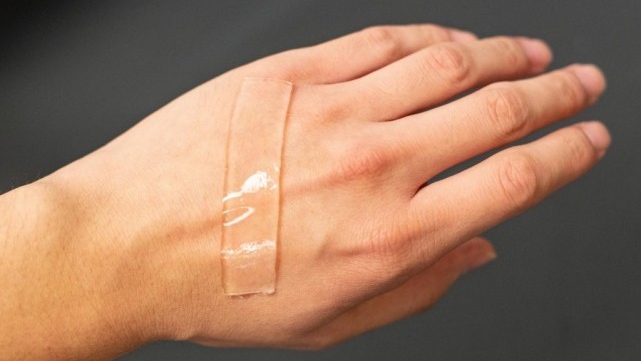The science of sticky: Making bandages stay on longer with ultrasound waves
 Hydrogel adhesive applied on skin under ultrasound probe (McGill University / Zhenwei Ma)
Hydrogel adhesive applied on skin under ultrasound probe (McGill University / Zhenwei Ma)
A lone bandage floating in a kiddie pool. Medical tape peeling up at the edges. Adhesives gone rogue in the gastrointestinal space.
Could these issues be a thing of the past?
For a team of researchers from McGill University, ETH Zurich and the University of British Columbia, that's the dream.
A study published in the journal Science found the stickiness of adhesive bandages can be manipulated with technology you're likely already familiar with: ultrasound waves.
The idea is to create "microbubbles," explains lead study author Zhenwei Ma, a McGillian-turned-Harvard research fellow.
These microbubbles -- tiny, gas-filled pockets smaller than 0.01mm in diameter -- allow sticky substances to bond more securely to the skin.
"It will temporarily open up the channels and allow the adhesive to temporarily and transiently get in," Ma told CTV News.
 Ultrasound microbubbles are used to control the efficacy of adhesion on the skin. (McGill University . Zhenwei Ma)
Ultrasound microbubbles are used to control the efficacy of adhesion on the skin. (McGill University . Zhenwei Ma)
"We're not changing the adhesive material," he clarified. "We're actually engineering our tissue temporarily so we can have better integration with the adhesive bandages."
The study found this approach, tested on the skin of pigs and rats, can make adhesion up to 10 times more effective.
THE OPERATING TABLE AND BEYOND
Although the technique has yet to be tested on humans, Ma says the research shows enormous promise.
"Some applications would be for internal organ repair," he said. "Sometimes you don't want it to adhere everywhere, right? I mean, think about your internal organs, especially in the internal GI tract, in the gastrointestinal space. For cardiovascular surgeries, for musculoskeletal tissue repair, sometimes you only want adhesion to happen at certain places."
The technology would permit surgeons to be selective about where the adhesive is stickiest -- and where it isn't.
"You don't want it to be sticking everywhere."
 A hydrogel adhesive applied on the skin Zhenwei Ma)
A hydrogel adhesive applied on the skin Zhenwei Ma)
Another possible application is within the realm of drug delivery through the skin.
"We also showed in our paper we can enable transdermal drug delivery," Ma explained. "It can trigger this delivery and strong integration with your skin or some other organs."
But what about your run-of-the-mill bandages and pimple patches? Will the technology ever appear in our bathroom cabinets?
It's possible, said Ma.
"Ultrasound is becoming so prevalent in not just in clinics, but also in point-of-care applications," he said.
With these advancements in portable ultrasound devices, there's no telling where the technology will go.
"Everything's happening so fast, and especially for these technologies. As long as you solve the scaling problem, if you can lower the costs."
CTVNews.ca Top Stories

BREAKING Police investigating shooting outside of Drake's Bridle Path mansion: source
Toronto police are investigating a shooting that took place outside of Drake’s Bridle Path mansion early Tuesday morning, a source tells CP24.
There's actually no such thing as vegetables. Here's why you should eat them anyway
The rumours are true: Vegetables aren't real — that is, in botany, anyway. While the term fruit is recognized botanically as anything that contains a seed or seeds, vegetable is actually a broad umbrella term.
'It looked so legit': Ontario man pays $7,700 for luxury villa found on Booking.com, but the listing was fake
An Ontario man says he paid more than $7,700 for a luxury villa he found on a popular travel website -- but the listing was fake.
The Met Gala was in full bloom with Zendaya, Jennifer Lopez, Mindy Kaling among the standout stars
The Met Gala and its fashionista A-listers on Monday included Jennifer Lopez, Zendaya and a parade of others in a swirl of flora and fauna looks on a green-tinged carpet lined by live foliage.
3 Indian nationals accused of murdering Hardeep Singh Nijjar facing court in B.C.
Three Indian nationals accused of murdering Sikh activist Hardeep Singh Nijjar are due to face court Tuesday over the killing that triggered a major diplomatic rift with India.
Israeli forces seize Rafah border crossing in Gaza, putting ceasefire talks on knife's edge
Israeli tanks seized control of Gaza's vital Rafah border crossing on Tuesday as Israel brushed off urgent warnings from close allies and moved into the southern city even as cease-fire negotiations with Hamas remained on a knife's edge.
Canadian cadets rock mullets and place second at U.S. military competition
Sporting mullets, Canadian Armed Forces officer cadets placed second in an annual military skills competition in the U.S.
Highlights from the 2024 Met Gala exhibit: Sleeping Beauty would wake up for these gowns
Sure, she was a royal princess and all. But there’s no way Sleeping Beauty — either before or after her nap — ever had quite the fabulous wardrobe that’s been assembled at the Metropolitan Museum of Art.
Noelia Voigt resigns as Miss USA, citing her mental health
Noelia Voigt, who was crowned Miss USA in November 2023, has announced she is resigning from her role, saying the decision is in the best interest of her mental health.






























